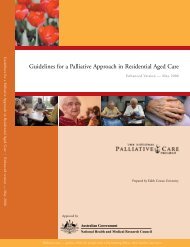PALLIATIVE And End OF LIFE CARE GLOSSARY OF TERMS ...
PALLIATIVE And End OF LIFE CARE GLOSSARY OF TERMS ...
PALLIATIVE And End OF LIFE CARE GLOSSARY OF TERMS ...
Create successful ePaper yourself
Turn your PDF publications into a flip-book with our unique Google optimized e-Paper software.
THE IMPORTANCE <strong>OF</strong> LANGUAGE<br />
As new understandings of the needs of people at the end of life emerge it is becoming apparent<br />
that we need to communicate clearly and unambiguously with groups of people with different<br />
perspectives and needs. The language that we use and the meanings that are attached to specific<br />
terms becomes increasingly problematic as we seek to negotiate new roles and responsibilities to<br />
ensure quality care for all Australians at the end of life.<br />
The lack of consistency in our use of terminology has created and will continue to create confusion<br />
as we seek to communicate and understand the needs of different cohorts of people facing the<br />
challenges of, providing or needing end of life care, including palliative care. The need to differentiate<br />
between the different resource and skill levels in services produced new terms, as did the need to<br />
respond to the challenges of increasing demand. For example, how might we explain the difference<br />
between palliative care and a palliative approach to a patient, their carer or family? What is the<br />
difference (if any) between the terms ‘life limiting’, ‘life threatening’ or ‘terminal illness’? Do the words<br />
carry different meaning for different cultures and different people? How are these words interpreted<br />
by patients, carers and health professionals? Which of them signify most closely the meaning we wish<br />
to communicate? What unintended meanings have become attached to particular words or terms?<br />
Lacking a precise or agreed definition these terms have come to be used to represent vastly different<br />
(qualitatively and quantitatively) things to different people.<br />
It is our hope that this Glossary will stimulate reflection, discussion and debate about the current use of<br />
some of these terms and that this in turn will lead to improved communication about end of life and<br />
palliative care.<br />
Sue Hanson<br />
National Quality & Standards Director<br />
Palliative Care Australia<br />
June 2008<br />
Glossary of terms | Page 3
















